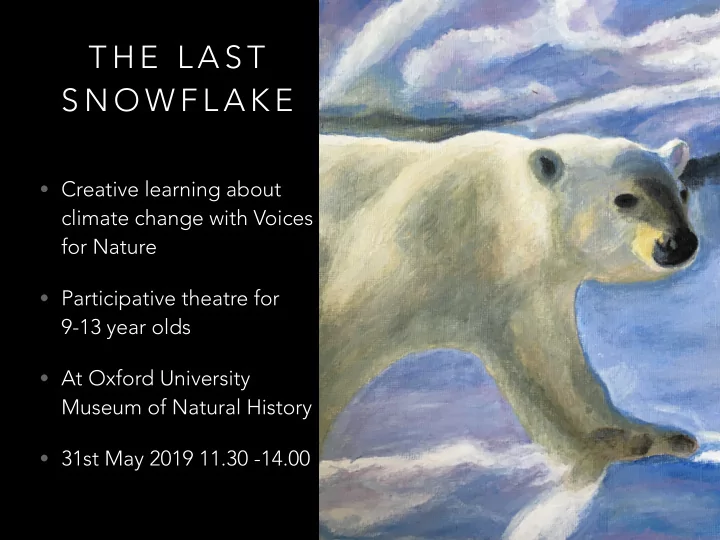

T H E L A S T S N O W F L A K E • Creative learning about climate change with Voices for Nature • Participative theatre for 9-13 year olds • At Oxford University Museum of Natural History • 31st May 2019 11.30 -14.00
T H E A R C T I C • includes, North Pole, Arctic Ocean and adjacent seas; parts of Alaska, Canada, Finland, Greenland, Iceland, Norway, Russia and Sweden • Has varying snow cover, sea ice and diverse land habitats (tundra and some boreal forest) • Home to many indigenous peoples and with towns and cities • Home to land animals (eg polar bears, muskox, arctic fox, wolf, caribou); sea animals (whales, seals); birds (eg snowy owl) plants (eg cotton grass, bearberry, birch)
A N TA R C T I C • The south polar region includes the South Pole, the Southern Ocean, with islands, mountain ranges and huge ice shelves • Almost entirely and permanently covered by ice and snow; only two species of flowering plants (Antarctic hair grass and pearlwort) but range of mosses, liverworts, lichens and microfungi • Home to seals, penguins, whales; albatrosses and petrels; fish (eg antarctic ice fish); squid; krill • No indigenous people, only scientists and other visitors
C L I M AT E C H A N G E A N D P O L A R R E G I O N S • Global warming leads to melting of ice (major loss of habitat) • Melting of ice leads to rising global water levels • Melting ice changes the salt levels of ocean (loss of habitat) • Melting permafrost releases carbon stored in soil making global warming worse • Less ice mass means less of the sun’s rays/heat reflected back into the atmosphere making temperatures rise more • Climate change impacts worst in Arctic region and Antarctic peninsula • Speed of change so fast that adaptation may not be possible for polar plants and creatures • Humans contribute to/cause climate change so WE CAN ALL DO SOMETHING TO HELP
www.voicesfornature.net Watercolour sketch of South Georgia, Antarctica by Bruce Pearson
Recommend
More recommend